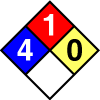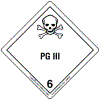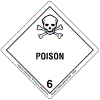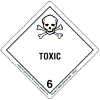Ricin: Biotoxin
CAS #:
9009-86-3
RTECS #: VJ2625000
UN #: 3462 (Guide 153)
Common Names:
- Ricine
- Ricins
Agent Characteristics
White powder. Can be prepared in liquid or crystalline form.
Ricin is an extremely toxic plant protein derived from the seeds of the castor bean plant (Ricinus communis). It is easily extracted from the castor bean meal that remains as a by-product of castor oil production. Ricin causes toxicity by inhibiting the formation (synthesis) of proteins in the cells of the exposed individual. Ricin may cause severe allergic reactions. Exposure to even a small amount of ricin may be fatal.
- Indoor Air: Ricin can be released into indoor air as fine particles (aerosol).
- Water: Ricin can be used to contaminate water.
- Food: Ricin can be used to contaminate food.
- Outdoor Air: Ricin can be released into outdoor air as fine particles (aerosol).
- Agricultural: If ricin is released into the air as fine particles (aerosol), it has the potential to contaminate agricultural products.
Ricin can be absorbed into the body through ingestion, inhalation, or eye contact. Ricin can be absorbed through abraded skin or through wounds, but probably not through intact skin, unless it is carried in a solvent that enhances absorption. Ricin can also be transmitted through the skin via small pellets or projectiles designed to carry toxin.
Personal Protective Equipment
First Responders should use a NIOSH-certified Chemical, Biological, Radiological, Nuclear (CBRN) Self Contained Breathing Apparatus (SCBA) with a Level A protective suit when entering an area with an unknown contaminant or when entering an area where the concentration of the contaminant is unknown. Level A protection should be used until monitoring results confirm the contaminant and the concentration of the contaminant.
NOTE: Safe use of protective clothing and equipment requires specific skills developed through training and experience.
Select when the greatest level of skin, respiratory, and eye protection is required. This is the maximum protection for workers in danger of exposure to unknown chemical hazards or levels above the IDLH or greater than the AEGL-2.
- A NIOSH-certified CBRN full-face-piece SCBA operated in a pressure-demand mode or a pressure-demand supplied air hose respirator with an auxiliary escape bottle.
- A Totally-Encapsulating Chemical Protective (TECP) suit that provides protection against CBRN agents.
- Chemical-resistant gloves (outer).
- Chemical-resistant gloves (inner).
- Chemical-resistant boots with a steel toe and shank.
- Coveralls, long underwear, and a hard hat worn under the TECP suit are optional items.
Select when the highest level of respiratory protection is necessary but a lesser level of skin protection is required. This is the minimum protection for workers in danger of exposure to unknown chemical hazards or levels above the IDLH or greater than AEGL-2. It differs from Level A in that it incorporates a non-encapsulating, splash-protective, chemical-resistant splash suit that provides Level A protection against liquids but is not airtight.
- A NIOSH-certified CBRN full-face-piece SCBA operated in a pressure-demand mode or a pressure-demand supplied air hose respirator with an auxiliary escape bottle.
- A hooded chemical-resistant suit that provides protection against CBRN agents.
- Chemical-resistant gloves (outer).
- Chemical-resistant gloves (inner).
- Chemical-resistant boots with a steel toe and shank.
- Coveralls, long underwear, a hard hat worn under the chemical-resistant suit, and chemical-resistant disposable boot-covers worn over the chemical-resistant suit are optional items.
Select when the contaminant and concentration of the contaminant are known and the respiratory protection criteria factors for using Air Purifying Respirators (APR) or Powered Air Purifying Respirators (PAPR) are met. This level is appropriate when decontaminating patient/victims.
- A NIOSH-certified CBRN tight-fitting APR with a canister-type gas mask or CBRN PAPR for air levels greater than AEGL-2.
- A NIOSH-certified CBRN PAPR with a loose-fitting face-piece, hood, or helmet and a filter or a combination organic vapor, acid gas, and particulate cartridge/filter combination or a continuous flow respirator for air levels greater than AEGL-1.
- A hooded chemical-resistant suit that provides protection against CBRN agents.
- Chemical-resistant gloves (outer).
- Chemical-resistant gloves (inner).
- Chemical-resistant boots with a steel toe and shank.
- Escape mask, face shield, coveralls, long underwear, a hard hat worn under the chemical-resistant suit, and chemical-resistant disposable boot-covers worn over the chemical-resistant suit are optional items.
Select when the contaminant and concentration of the contaminant are known and the concentration is below the appropriate occupational exposure limit or less than AEGL-1 for the stated duration times.
- Limited to coveralls or other work clothes, boots, and gloves.
Emergency Response
- Ricin is stable under ambient conditions.
- When heated to decomposition, ricin emits toxic nitrogen oxides.
- Not established/determined
- Ricin is combustible.
- Ricin is not volatile, but it may be spread by efforts to extinguish the fire.
- Avoid generating dust.
- Use foam, dry chemical powder, BCF (where regulations permit), carbon dioxide, water spray, or fog (large fires only).
- If the situation allows, control and properly dispose of run-off (effluent).
- If a tank, rail car, or tank truck is involved in a fire, isolate it for 0.5 mi (800 m) in all directions; also, consider initial evacuation for 0.5 mi (800 m) in all directions.
- This agent is not included in the DOT ERG 2004 Table of Initial Isolation and Protective Action Distances.
- In the DOT ERG 2004 orange-bordered section of the guidebook, there are public safety recommendations on how to immediately isolate a ricin (Guide 153) spill or leak area for at least 150 ft (50 m) for liquids and 75 ft (25 m) for solids in all directions.
- Not established/determined
- Health: 4
- Flammability: 1
- Reactivity: 0
- Special:

- OSHA: Not established/determined
- NIOSH: Not established/determined
- AIR MATRIX
Gatto-Menking DL, Hao Y, Bruno JG, Goode MT, Miller M, Zulich AW. [1995]. Sensitive detection of biotoxoids and bacterial spores using an immunomagnetic electrochemiluminescence sensor. Biosens Bioelectron 10(6-7):501-507.O’Brien T, Johnson LH III, Aldrich JL, Allen SG, Liang LT, Plummer AL, Krak SJ, Boiarski AA [2000]. The development of immunoassays to four biological threat agents in a bidiffractive grating biosensor. Biosens Bioelectron 14(10-11):815-828.Taitt CR, Anderson GP, Lingerfelt BM, Feldstein MJ, Ligler FS [2002]. Nine-analyte detection using an array-based biosensor. Anal Chem 74(23):6114-6120. - OTHER
No references were identified for this sampling matrix for this agent. - SOIL MATRIX
Gatto-Menking DL, Hao Y, Bruno JG, Goode MT, Miller M, Zulich AW [1995]. Sensitive detection of biotoxoids and bacterial spores using an immunomagnetic electrochemiluminescence sensor. Biosens Bioelectron 10(6-7):501-507. - SURFACES
Anderson GP, King KD, Gaffney KL, Johnson LH [2000]. Multi-analyte interrogation using the fibre optic biosensor. Biosens Bioelectron 14(10-11):771-777.Bayler SA, Rees DA [1982]. Analysis of the proteins, glycoproteins and glycosaminoglycans of fibroblast adhesions to substratum. Biochim Biophys Acta (BBA)—Biomembranes 689(2):351-362.Narang U, Anderson GP, Ligler FS, Burans J [1997]. Fiber optic-based biosensor for ricin. Biosens Bioelectron12(9-10):937-945.O’Brien T, Johnson LH III, Aldrich JL, Allen SG, Lian LT, Plummer AL, Krak SJ, Boiarski AA [2000]. The development of immunoassays to four biological threat agents in a bidiffractive grating biosensor. Biosens Bioelectron 14(10-11):815-828.Smallshaw JE, Firan A, Fulmer JR, Ruback SL, Ghetie V, Vitetta ES [2002]. A novel recombinant vaccine which protects mice against ricin intoxication. Vaccine 20:(27-28):3422-3427.
Taitt CR, Anderson GP, Lingerfelt BM, Feldstein MJ, Ligler FS [2002]. Nine-analyte detection using an array-based biosensor. Anal Chem 74(23):6114-6120.
Wadkins RM, Golden JP, Pritsiolas LM, Ligler FS [1998]. Detection of multiple toxic agents using a planar array immunosensor. Biosens Bioelectron 13(3-4):407-415.
Wannemacher RW Jr., Hewetson JF, Lemley PV, Poli MA, Dinterman RE, Thompson WL, Franz DR [1992]. Comparison of detection of ricin in castor bean extracts by bioassays, immunoassays, and chemical procedures. Toxicon 30(5-6):562.
Wellner RB, Hewetson JF, Ploi MA [1995]. Ricin–mechanism of action, detection, and intoxication. J Toxicol-Toxin Rev 14(4):483-522.
Xinglong Y, Lequn Z, Hong J, Haojuan W, Chunyong Y, Shenggeng Z [2001]. Immunosensor based on optical heterodyne phase detection. Sensors Actuators B: Chem 76(1-3):199-202.
- WATER
Anderson GP, King KD, Gaffney KL, Johnson LH [2000]. Multi-analyte interrogation using the fibre optic biosensor. Biosens Bioelectron 14(10-11):771-777.Carter RM, Jacobs MB, Lubrano GJ, Guilbault GG [1995]. Piezoelectric detection of ricin and affinity-purified goat anti-ricin antibody. Anal Lett 28(8):1379-1386.Darby SM, Miller ML, Allen RO [2001]. Forensic determination of ricin and the alkaloid marker ricinine from castor bean extracts. J Forensic Sciences 46(5):1033-1042.Delehanty JB, Ligler FS [2002]. A microarray immunoassay for simultaneous detection of proteins and bacteria. Anal Chem 74(21):5681-5687.Despeyroux D, Walker N, Perace M, Fisher M, McDonnell M, Bailey SC, Griffiths GD, Watts P [2000]. Characterization of ricin heterogeneity by electrospray mass spectrometry, capillary electrophoresis and resonant mirror. Anal Biochem 279(1):23-36.
Gatto-Menking DL, Hao Y, Bruno JG, Goode MT, Miller M, Zulich AW. [1995]. Sensitive detection of biotoxoids and bacterial spores using an immunomagnetic electrochemiluminescence sensor. Biosens Bioelectron 10(6-7):501-507.
Griffiths GD, Newman H, Gee DJ [1986]. Identification and quantification of ricin toxin in animal tissues using ELISA. J Forensic Sci Soc 26(5):349-358.
Hines HB, Brueggemann EE [1994]. Factors affecting the capillary electrophoresis of ricin, a toxic glycoprotein. J Chromatogr A 670(1-2):199-208.
Koja N, Shibata T, Mochida K [1980]. Emzyme-linked immunoassay of ricin. Toxicon 18(5-6):611-618.
Mi JQ, Gao J, Li YZ, Chang WB, Ci YX [2001]. Ricin determination by temperature controlled phase-separation immunoassay. Anal Lett 34(7):1143-1151.
Narang U, Anderson GP, Ligler FS, Burans J [1997]. Fiber optic-based biosensor for ricin. Biosens Bioelectron 12(9-10):937-945.
Poli MA, Rivera VR, Hewetson JF, Merrill GA [1994]. Detection of ricin by colorimetric and chemiluminescence ELISA. Toxicon 32(11):1371-1377.
Puu G [2001]. An approach for analysis of protein toxins based on thin films of lipid mixtures in an optical biosensor. Anal Chem 73(1):72-79.
Shyu HF, Chiao DJ, Liu HW, Tang SS [2002]. Monoclonal antibody-based enzyme immunoassay for detection of ricin. Hybridoma and Hybridomics 21(1):69-73.
Taitt CR, Anderson GP, Lingerfelt BM, Feldstein MJ, Ligler FS [2002]. Nine-analyte detection using an array-based biosensor. Anal Chem 74(23):6114-6120.
Yu H, Raymonda JW, McMahon TM, Campagnari AA [2000]. Detection of biological threat agents by immunomagnetic microsphere-based solid-phase fluorogenic and electrochemiluminescence. Biosens Bioelectron 14(10-11):829-840.
Signs/Symptoms
Physical findings and signs of ricin exposure can occur after a latent (symptom-free) period of a few hours to several days. Effects following ingestion of ricin generally occur within a few hours after ingestion. Gastrointestinal effects generally occur within 6 hours of ricin exposure. Effects on the liver, central nervous system (CNS), kidneys, and adrenal glands typically occur 2 to 5 days after exposure and reflect ricin’s cytotoxic effect. Patients/victims may be asymptomatic prior to the occurrence of these cytotoxic physical findings. Death may occur between 3 and 5 days after the initial exposure to ricin.
Ricin poisons the cells of the body by blocking (inhibiting) the formation (synthesis) of proteins. Contact of ricin with the skin, eyes, lungs, or the moist lining of body passages and cavities (mucous membranes) can cause severe irritation, inflammation, and internal bleeding (hemorrhage). The health effects caused by ricin depend on the route of exposure and the amount of ricin to which the patient/victim is exposed. Ingestion of ricin produces severe vomiting (emesis) and diarrhea which may result in serious dehydration (hypovolemic shock) and multi-system organ failure affecting the gastrointestinal (GI) tract, kidneys, liver and pancreas; these effects are potentially fatal. Inhalation of ricin may cause cough, fever, fluid accumulation in the lungs (pulmonary edema) and respiratory distress; these effects are potentially fatal. Inhalation of ricin may also result in an allergic reaction resulting in nasal passage congestion, dryness and soreness of the throat, swelling of the eyelids and lips, bronchial irritation and possibly asthma. Ricin dust in the eye can cause localized inflammatory lesions. Lesions resulting from ricin exposure resemble alkaline caustic burns, but they are usually delayed two or more hours after exposure. Illness resulting from exposure is not communicable.
- Mild to moderate: Tear production (lacrimation); swelling, redness, and inflammation of the membranes (conjunctivitis).
- Severe: Severe tissue destruction, possible bleeding of the membrane in the rear of the eye (retinal hemorrhage), impaired vision, blindness.
- Contact with the eyes may result in whole-body (systemic) toxicity and possibly death.
- Burning pain in the mouth, throat, and esophagus; nausea; difficulty swallowing (dysphagia); vomiting (emesis); vomiting blood (hematemesis); diarrhea; bloody stools (melena); abdominal (epigastric) cramps/pain; severe inflammation of the lining of the stomach and intestine (gastroenteritis); bleeding (hemorrhage) in the stomach and intestines; drowsiness (somnolence); disorientation; weakness; stupor; convulsions; excessive thirst (polydipsia); blood in the urine (hematuria); reduced excretion of urine (oliguria); multi-system organ failure; collapse of the blood vessels (vascular collapse); shock; and death.
- May cause severe lung damage and death.
- Symptoms may include fever, cough, accumulation of fluid in the lungs (pulmonary edema), respiratory distress, and death.
- The risk of toxicity from skin exposure to ricin is low.
- Ricin may be absorbed through irritated, damaged, or injured skin or through normal skin if aided by a solvent carrier.
- There is a potential for allergic skin reactions to occur; signs include redness (erythema), blistering (vesication), irritation, and pain.
Decontamination
The purpose of decontamination is to make an individual and/or their equipment safe by physically removing toxic substances quickly and effectively. Care should be taken during decontamination, because absorbed agent can be released from clothing and skin as a gas. Your Incident Commander will provide you with decontaminants specific for the agent released or the agent believed to have been released.
The following are recommendations to protect the first responders from the release area:
- Position the decontamination corridor upwind and uphill of the hot zone.
- The warm zone should include two decontamination corridors. One decontamination corridor is used to enter the warm zone and the other for exiting the warm zone into the cold zone. The decontamination zone for exiting should be upwind and uphill from the zone used to enter.
- Decontamination area workers should wear appropriate PPE. See the PPE section of this card for detailed information.
- A solution of detergent and water (which should have a pH value of at least 8 but should not exceed a pH value of 10.5) should be available for use in decontamination procedures. Soft brushes should be available to remove contamination from the PPE.
- Labeled, durable 6-mil polyethylene bags should be available for disposal of contaminated PPE.
The following methods can be used to decontaminate an individual:
- Decontamination of First Responder:
- Begin washing PPE of the first responder using soap and water solution and a soft brush. Always move in a downward motion (from head to toe). Make sure to get into all areas, especially folds in the clothing. Wash and rinse (using cold or warm water) until the contaminant is thoroughly removed.
- Remove PPE by rolling downward (from head to toe) and avoid pulling PPE off over the head. Remove the SCBA after other PPE has been removed.
- Place all PPE in labeled durable 6-mil polyethylene bags.
- Decontamination of Patient/Victim:
- Remove the patient/victim from the contaminated area and into the decontamination corridor.
- Remove all clothing (at least down to their undergarments) and place the clothing in a labeled durable 6-mil polyethylene bag.
- Thoroughly wash and rinse (using cold or warm water) the contaminated skin of the patient/victim using a soap and water solution. Be careful not to break the patient/victim’s skin during the decontamination process, and cover all open wounds.
- Cover the patient/victim to prevent shock and loss of body heat.
- Move the patient/victim to an area where emergency medical treatment can be provided.
First Aid
Initial treatment is primarily supportive.
There is no antidote for ricin toxicity.
- Immediately remove the patient/victim from the source of exposure.
- Immediately wash eyes with large amounts of tepid water for at least 15 minutes.
- Seek medical attention immediately.
- Immediately remove the patient/victim from the source of exposure.
- Ensure that the the patient/victim has an unobstructed airway.
- Do not induce vomiting (emesis).
- Administer charcoal as a slurry (240 mL water/30 g charcoal). Usual dose: 25 to 100 g in adults/adolescents, 25 to 50 g in children (1 to 12 years), and 1 g/kg in infants less than 1 year old.
- Seek medical attention immediately.
- Immediately remove the patient/victim from the source of exposure.
- Evaluate respiratory function and pulse.
- Ensure that the patient/victim has an unobstructed airway.
- If shortness of breath occurs or breathing is difficult (dyspnea), administer oxygen.
- Assist ventilation as required. Always use a barrier or bag-valve-mask device.
- If breathing has ceased (apnea), provide artificial respiration.
- Seek medical attention immediately.
- Immediately remove patient/victim from the source of exposure.
- See the decontamination section for patient/victim decontamination procedures.
- Seek medical attention immediately.
Long-Term Implications
If the patient/victim can be rapidly transported to an emergency department following decontamination, stomach pumping (gastric lavage) may be considered after the airway has been secured. Gastric lavage is recommended only after ingestion of a life-threatening amount of the agent, and only if it can be done shortly after ingestion (generally within 1 hour). The risk of worsening injury to the lining of the gastrointestinal (GI) tract must be considered. Fluid and electrolyte balance should be monitored and restored if abnormal.
Late phase complications are related to ricin’s cell-killing (cytotoxic) effects on the liver, central nervous system (CNS), kidneys, and adrenal glands; and they typically occur 2 to 5 days after exposure. The patient/victim may exhibit no physical findings during the preceding 1 to 5 days.
Information is unavailable about the carcinogenicity, developmental toxicity, or reproductive toxicity from chronic or repeated exposure to ricin. Chronic or repeated exposure to ricin may result in an allergic syndrome characterized by nose and throat congestion, eye itchiness and watering, chest tightness, and in severe cases wheezing.
On-Site Fatalities
- Consult with the Incident Commander regarding the agent dispersed, dissemination method, level of PPE required, location, geographic complications (if any), and the approximate number of remains.
- Coordinate responsibilities and prepare to enter the scene as part of the evaluation team along with the FBI HazMat Technician, local law enforcement evidence technician, and other relevant personnel.
- Begin tracking remains using waterproof tags.
- Wear PPE until all remains are deemed free of contamination.
- Establish a preliminary (holding) morgue.
- Gather evidence, and place it in a clearly labeled impervious container. Hand any evidence over to the FBI.
- Remove and tag personal effects.
- Perform a thorough external evaluation and a preliminary identification check.
- See the Decontamination section for decontamination procedures.
- Decontaminate remains before they are removed from the incident site.
Occupational Exposure Limits
- NIOSH REL:
- Not established/determined
- OSHA PEL:
- Not established/determined
- ACGIH TLV:
- Not established/determined
- NIOSH IDLH: Not established/determined
- DOE TEEL:
- TEEL-0: 0.025 mg/m3
- TEEL-1: 0.075 mg/m3
- TEEL-2: 0.5 mg/m3
- TEEL-3: 1.5 mg/m3
- AIHA ERPG:
- ERPG-1: Not established/determined
- ERPG-2: Not established/determined
- ERPG-3: Not established/determined
Acute Exposure Guidelines
| 5 min | 10 min | 30 min | 1 hr | 4 hr | 8 hr | |
|---|---|---|---|---|---|---|
| AEGL 1 (discomfort, non-disabling) – mg/m3 |
Not established/ determined | Not established/ determined | Not established/ determined | Not established/ determined | Not established/ determined | Not established/ determined |
| AEGL 2 (irreversible or other serious, long-lasting effects or impaired ability to escape) – mg/m3 |
Not established/ determined | Not established/ determined | Not established/ determined | Not established/ determined | Not established/ determined | Not established/ determined |
| AEGL 3 (life-threatening effects or death) – mg/m3 |
Not established/ determined | Not established/ determined | Not established/ determined | Not established/ determined | Not established/ determined | Not established/ determined |
Decontamination (Environment and Equipment)
The following methods can be used to decontaminate the environment/spillage disposal:
- Do not touch or walk through the spilled agent if at all possible. However, if you must, personnel should wear the appropriate PPE during environmental decontamination. See the PPE section of this card for detailed information.
- Keep combustibles (e.g., wood, paper, and oil) away from the spilled agent.
- Use water spray to reduce vapors or divert vapor cloud drift. Avoid allowing water runoff to contact the spilled agent.
- Do not direct water at the spill or the source of the leak.
- Stop the leak if it is possible to do so without risk to personnel.
- Prevent entry into waterways, sewers, basements, or confined areas.
- Ventilate the area.
Agents can seep into the crevices of equipment making it dangerous to handle. The following methods can be used to decontaminate equipment:
- Not established/determined
Agent Properties
- Chemical Formula:
Not established/determined - Aqueous solubility:
Soluble - Boiling Point:
Decomposes - Density:
Not established/determined - Flammability:
Not established/determined - Flashpoint:
Not established/determined
- Ionization potential:
Not established/determined - Log Kbenzene-water:
Not established/determined - Log Kow (estimated):
Not established/determined - Melting Point:
Not established/determined - Molecular Mass:
66,000 (approx.)
- Soluble In:
10% sodium chloride solution - Specific Gravity:
Not established/determined - Vapor Pressure:
Negligible - Volatility:
Not volatile
Hazardous Materials Warning Labels/Placards
- Shipping Name:
Toxin, extracted from living sources, n.o.s. - Identification Number:
3462 (Guide 153) - Hazardous Class or Division:
6.1 - Subsidiary Hazardous Class or Division:
- Label:
Poison (Toxic)
PG III - Placard Image:
Trade Names and Other Synonyms
- African coffee tree (USA)
- Carrapateiro (Brazil)
- Castor (Argentine)
- Castor bean (USA)
- Castor-oil (USA)
- Higuereta (Cuba, Puerto Rico)
- Koli, Pa’aila (Hawaii)
- La’au-‘aila (Hawaii)
- Mamona (Brazil)
- Mamoneiro (Brazil)
- Palma de Cristo (Uruguay)
- Palma-cristi (Brazil)
- Ricino (Argentina)
- Steadfast (USA)
- Tartago (Uruguay)
In the event of a poison emergency, call the poison center immediately at 1-800-222-1222. If the person who is poisoned cannot wake up, has a hard time breathing, or has convulsions, call 911 emergency services.
For information on who to contact in an emergency, see the CDC website at emergency.cdc.gov or call the CDC public response hotline at (888) 246-2675 (English), (888) 246-2857 (Español), or (866) 874-2646 (TTY).
The user should verify compliance of the cards with the relevant STATE or TERRITORY legislation before use. NIOSH, CDC 2003.



